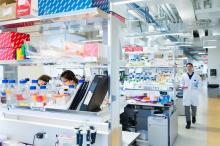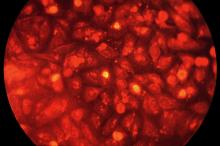Researchers at the University of British Columbia have identified a small molecule that prevents bacteria from forming into biofilms, a frequent cause of infections. The anti-biofilm peptide works on a range of bacteria including many that cannot be treated by antibiotics.
“Currently there is a severe problem with antibiotic-resistant organisms,” says Bob Hancock, a professor in UBC’s Dept. of Microbiology and Immunology and lead author of the study published today in PLOS Pathogens. “Our entire arsenal of antibiotics is gradually losing effectiveness.”
Many bacteria that grow on skin, lung, heart and other human tissue surfaces form biofilms, highly structured communities of bacteria that are responsible for two-thirds of all human infections. There are currently no approved treatments for biofilm infections and bacteria in biofilms are considerably more resistant to standard antibiotics.
Hancock and his colleagues found that the peptide known as 1018–consisting of just 12 amino acids, the building blocks of protein–destroyed biofilms and prevented them from forming.
Bacteria are generally separated into two classes, Gram-positives and Gram-negatives, and the differences in their cell wall structures make them susceptible to different antibiotics. 1018 worked on both classes of bacteria as well as several major antibiotic-resistant pathogens, including E. coli, Pseudomonas aeruginosa and MRSA.
“Antibiotics are the most successful medicine on the planet. The lack of effective antibiotics would lead to profound difficulties with major surgeries, some chemotherapy treatments, transplants, and even minor injuries,” says Hancock. “Our strategy represents a significant advance in the search for new agents that specifically target bacterial biofilms.”
Musqueam First Nation land acknowledegement
We honour xwməθkwəy̓ əm (Musqueam) on whose ancestral, unceded territory UBC Vancouver is situated. UBC Science is committed to building meaningful relationships with Indigenous peoples so we can advance Reconciliation and ensure traditional ways of knowing enrich our teaching and research.
Learn more: Musqueam First Nation
Faculty of Science
Office of the Dean, Earth Sciences Building2178–2207 Main Mall
Vancouver, BC Canada
V6T 1Z4


